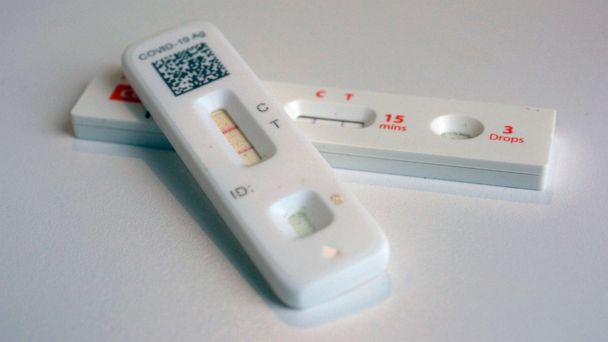Infection
Why you should wait a few days before taking an at-home COVID test if you’re sick
The best time to take an at-home COVID-19 test may be on the fourth day of having symptoms, according to a study published in the journal Clinical Infectious Diseases.
Researchers looked at nearly 350 people and found that viral load peaked a few days after symptoms started.
“Viral load just refers to the amount of virus that is replicating in your body, So the more virus that is replicating, the more chance of a test turning positive,” said John Brownstein, Ph.D., chief innovation officer at Boston Children’s Hospital and an ABC News Contributor.
“Right at the beginning point of an infection, there’s limited viral copies. But as the infection progresses, you’ll have an increasing amount of virus replicating in your body,” he added.
The study found that at-home tests were most accurate on the fourth day of symptoms. They could still pick up some infections in the first three days but were more likely to be negative. The findings show that people should not be able to rule out COVID-19 just based on a negative test early on after symptoms start, the study authors said.
Most of the people in the study had either been vaccinated or had a previous COVID infection.
Current guidelines recommend testing immediately if you have symptoms and if it’s negative, following up at least 48 hours later with another antigen test or opting to take a PCR test as soon as possible, according to the Centers for Disease Control and Prevention.
“New variants may cause differences in [the] timing of viral load. It may affect the timing of when tests may be the most optimal to detect the virus,” Brownstein said.
“This study highlights the challenges of optimizing test performance and timing for the most effective action,” he added.
The federal government recently re-launched a program that allows Americans to order free COVID tests straight to their home. Tests can be ordered at CovidTests.Gov.
Some “expired” COVID tests have also had their expiration dates extended by the Food and Drug Administration. At-home tests typically have a shelf life of around 4-6 months from the day they were manufactured.
Federal health authorities continue to encourage everyone to anonymously report their at-home COVID tests to MakeMyTestCount.org.
COVID hospitalizations have declined for two consecutive weeks, following a steady uptick for about two months.
Updated COVID vaccines were recently greenlit by federal health authorities but had a rocky distribution start following reports of supply issues and insurance snags, according to the Department of Health and Human Services. The issues appear to have been resolved.
“At this time, we understand that systemic technical issues have been largely, if not completely, resolved and are not limiting patient access to vaccines. Should further issues arise, we stand ready to swiftly implement system improvements,” the insurance companies said in a letter to the secretary of Health and Human Services, Xavier Becerra, obtained by ABC News.
Retailers also confirmed that updated COVID vaccines were now available in greater supply.
“All stores now have the supply needed to meet demand in their communities. Additional appointments have been added to our scheduler and will continue to be made available at our sites based on supply. We are updating Walgreens.com and our app with real-time appointment availability so patients have accurate information,” Walgreens told ABC News in a statement.
“I think we’re through the sort of crunch of the initial rollout where you had that sort of massive demand immediately. That has now stabilized, demand has stabilized, supply has stabilized, meaning that there’s a lot of options for people out there to get access to the booster right now,” Brownstein said.
ABC News’ Cheyenne Haslett and Dr. Genevieve Jing contributed to this report.

